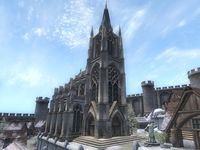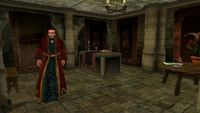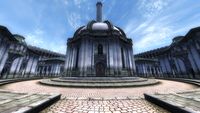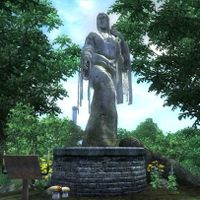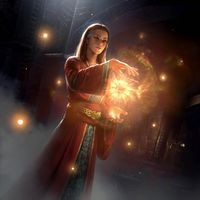Lore:Imperial Cult
- "The missionary arm of the great faiths, the Imperial Cult brings divine inspiration and consolation to the Empire's remote provinces. The cults combine the worship of the Nine Divines: the Aedra Akatosh, Dibella, Arkay, Zenithar, Mara, Stendarr, Kynareth, and Julianos, and the Talos Cult, veneration of the divine god-hero Tiber Septim, founder and patron of the Empire. Imperial Cult priests provide worship and services for all these gods at the Imperial Cult shrines in settlements throughout Vvardenfell." —For my Gods and Emperor
The main religion of the Empire can trace its origins back Saint Alessia's institution of worship of the Eight Divines as a synthesis between the Aldmeri gods and the Nordic pantheon.[1] Although known as the Imperial Cult in the provinces, strictly speaking this term refers the missionary arm of the religion, present in provinces such as Morrowind.[2] As the majority religion in Cyrodiil, it is more commonly known in that province simply as the Church[3][4][5] or the Chapel.[6] After the apotheosis of Tiber Septim, Imperials began to spread belief in the Nine Divines, incorporating worship of the Empire's god-hero Talos.[2] However, the Third Empire was forced to sign the White-Gold Concordat in 4E 175, which outlawed Talos worship.[7]
Hierarchy[edit]
There are different positions in the Cult; for example, lay healers gather ingredients for health and healing potions, and minister to the sick and hurt in poor and isolated communities. Almoners gather alms from fellow members, and people with good mercantile skills often fall into this line of work. Shrine sergeants help keep order at shrines and often act as couriers; in some cases they will be called upon to escort priests and fight for the faith against groups like witches.[8] Advancement within the cult often favors those who are proficient with Restoration, Mysticism, Conjuration, and blunt weaponry so as to avoid bloodshed. Skills in enchanting and speech are also valued by the cult.[2] The usual ranks within the cult are, in ascending order of seniority: Layman, Novice, Initiate, Acolyte, Adept, Disciple, Oracle, Invoker, Theurgist, and Primate.[9] Laypeople can also be granted honorary membership of the Church as a Pilgrim if they are called to carry out a holy pilgrimage.[10] The Church also venerates Living Saints, individuals who have received a calling to live by the commands of their chosen Divine as an example to others.[11] Certain saints continue to be venerated long after death,[12][13][14] and devotions are often made collectively to the Communion of Saints.[15]
Organization[edit]
The cult is based out of Cyrodiil, and its ministries across the Empire are handled by the Council of the Nine, consisting of the Primates of Cyrodiil's various Great Chapels.[16] In Cyrodiil, the Church is divided into eight parishes, each dedicated to a divine. Bravil Parish is devoted to Mara,[16] Kvatch to Akatosh, Anvil to Dibella, Chorrol to Stendarr, Cheydinhal to Arkay, Skingrad to Julianos, Bruma to Talos, and Leyawiin to Zenithar.[17] Each of these cities possesses a Great Chapel devoted to the worship of their parish patron. Kynareth does not possess a Great Chapel, as the Church considers the Chapel of Kynareth to be the natural world; her center of worship is therefore a shrine located deep in the Great Forest west of the Imperial City.[18]
During the Imperial colonization of Vvardenfell in the late Third Era, the Imperial Chapels in Ebonheart served as the headquarters of the cult in Vvardenfell District. The cult offered services at shrines in the Imperial Legion forts established throughout the region.[9] The cult at that time maintained relatively good relations with the other guilds of Morrowind, being allies with the Imperial Legion, Blades, and Fighters Guild and on friendly terms with the Mages Guild, House Hlaalu, and House Redoran.[2]
There is an institute called the Imperial Seminary, which focuses on the study of religion and also prepares people for the role of clergy. Based on speculation that certain spirits on Nirn can use the deeds of a mortal to elevate themselves to godlike status, a notable member of the seminary, Motusuo, suggested that these spirits could be the remnants of lost and nigh-forgotten deities, who upon losing their following reverted to their most basic form.[19] The seminary archived an abridged version of Mythic Aurbis, a theory crafted by Artaeum apologists for Emperor Uriel Septim V. The summary was featured in The Monomyth, a book containing other creation myths.[20]
Gallery[edit]
See Also[edit]
- For game-specific information, see the Morrowind and Oblivion articles.
- Imperial Saints — A list of saints venerated by the Church.
Books[edit]
- For my Gods and Emperor by Imperial Cult — A handbook for new Imperial Cult members
References[edit]
- ^ Shezarr and the Divines — Faustillus Junius
- ^ a b c d For my Gods and Emperor — Imperial Cult
- ^ Gaston Tussaud's dialogue in Oblivion
- ^ The Stone of St. Alessia quest in Oblivion
- ^ The Prophet's dialogue in Oblivion: Knights of the Nine
- ^ Avrus Adas' dialogue in Oblivion
- ^ The Great War — Legate Justianus Quintius
- ^ Thelsa Dral the Witch quest in Morrowind
- ^ a b Imperial Cult in Morrowind
- ^ Pilgrimage quest in Oblivion
- ^ Olava the Fair's dialogue in Oblivion
- ^ Sir Ralvas' dialogue in Oblivion: Knights of the Nine
- ^ Carodus Oholin's dialogue in Oblivion: Knights of the Nine
- ^ Guide to Chorrol — Alessia Ottus
- ^ Guide to the Imperial City — Alessia Ottus
- ^ a b Chana Mona's dialogue in Oblivion
- ^ Chapels in Oblivion
- ^ Avita Vesnia's dialogue in Oblivion
- ^ Overview of Gods and Worship — Brother Hetchfield
- ^ The Monomyth
|
|||||||||||||||||||||||
